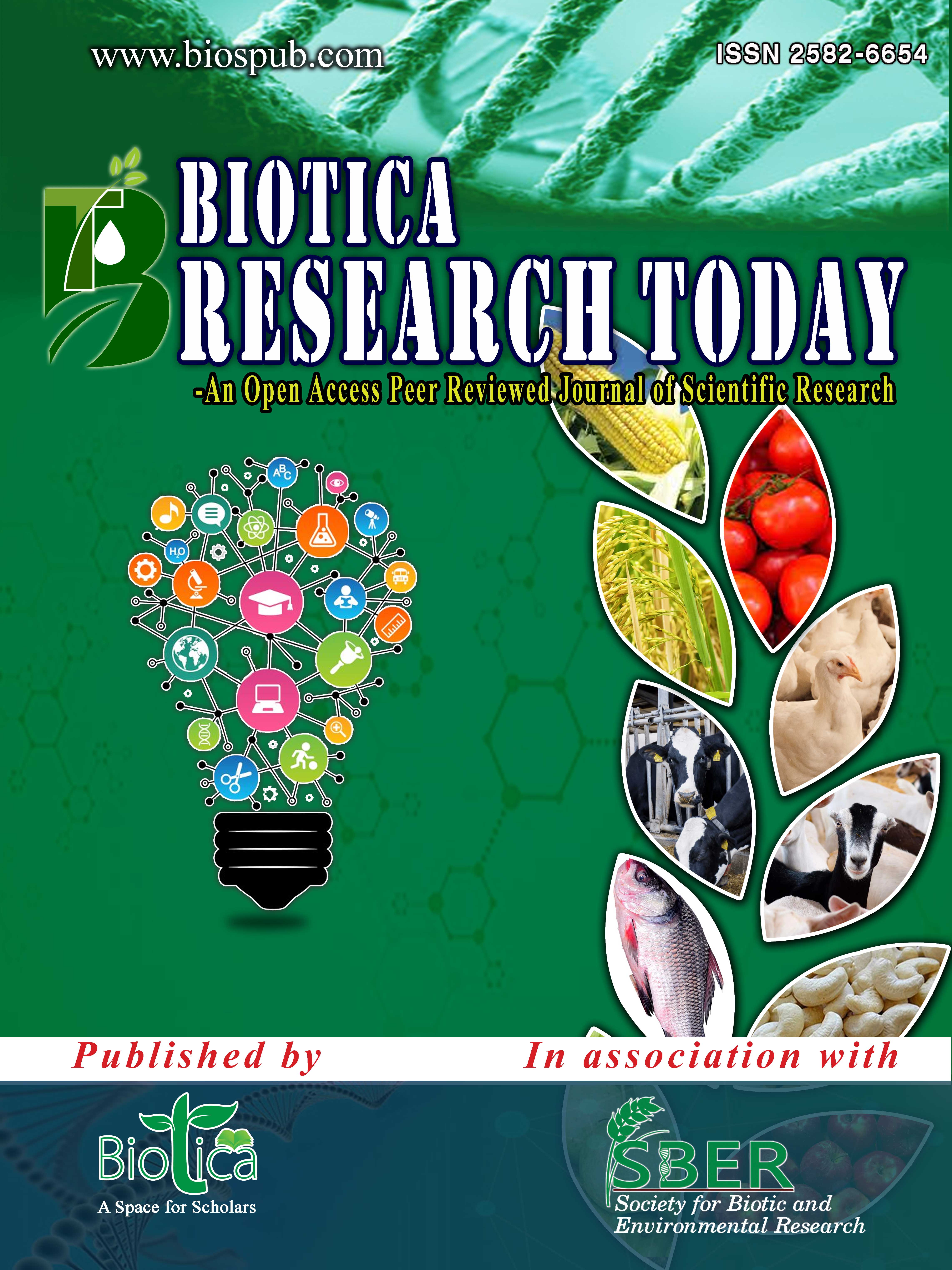Pathogenecity and in-vitro Assessment of Some Fungicides on the Mycelial Growth of Rice Blast Pathogen (Magnaporthe oryzae B.Cauch) in Jigawa State, Nigeria
DOI:
https://doi.org/10.54083/PHA/2.1.2024/07-12Keywords:
Fungicides, in vitro, Mycelial growth, Pathogenecity, Rice blastAbstract
It is beyond any reasonable doubt that rice (Oryza sativa L.) ranks first among its counterparts cereal food crops in the world, being unmatched in both worldwide demand and economic significance. Serving as a staple food to about two-thirds of the world population, the cultivation of this crop faces various constraints due to numerous infections, among which rice blast stands out as a significant issue affecting rice production in Jigawa state, Nigeria. In order to avert the reported situation, an in-vitro experiment was conducted using five selected fungicides through food poisoning technique at 10,000, 1,000 and 100 ppm. Results of in-vitro test showed that among the five tested fungicides, Mancozeb and Hexaconazole appeared to have higher fungicidal activity against M. oryzae by completely inhibiting the fungal growth at 1,000 and 10,000 ppm of Z-force (Mancozeb) and the growth was restricted at 10,000 ppm of Hexacal (50 g Hexaconazole litre-1). The fungal mycelium's expansion of M. oryzae at 10,000 ppm of Dress-force (Imidacloprid 20% + Metalaxyl-M 20% + Tebuconazole 2% WS) was 9.33 mm, Seed care (Imidacloprid 10% + Thiram 10% WS) was 14.67 mm and for the Blast force (Isoprothiolane 40% WP) was 16.00 mm. The plates used as control exhibited the most extensive mycelial growth of the tested pathogen (measuring 59.33 mm). This connotes that of the five fungicides tested, Mancozeb and Hexaconazole could best be used for the eradication of M. oryzae infection on rice pending further research.
Downloads
References
Al Noman, M.A., Shamsi, S., 2021. An improved and effective protocol for monoconidial isolation of Pyricularia oryzae. Journal of Plant Pathology 103, 317-320. DOI: https://doi.org/10.1007/s42161-020-00732-x.
Amayo, R., Oparok, T., Lamo, J., Drissa, S., Edema, R., Tusiime, G., 2020. Rice blast prevalence in smallholder rice farmlands in Uganda. Journal of Agricultural Science 12(10), 105-115. DOI: https://doi.org/10.5539/jas.v12n10p105.
Balol, G., Talekar, S.C., Satish, R.G., 2022. Efficacy of various fungicides on the management of rice blast disease caused by Pyricularia oryzae (Cav.) under field conditions in Dharwad district of Karnataka. International Journal of Plant Sciences 17(2), 214-217. DOI: https://doi.org/10.15740/HAS/IJPS/17.2/214-217.
Borer, E.T., Paseka, R.E., Peace, A., Asik, L., Everett, R., Frenken, T., González, A.L., Strauss, A.T., Van de Waal, D.B., White, L.A., Seabloom, E.W., 2022. Disease‐mediated nutrient dynamics: Coupling host-pathogen interactions with ecosystem elements and energy. Ecological Monographs 92(2), e1510. DOI: https://doi.org/10.1002/ecm.1510.
Chakraborty, B., Banerjee, S., Samanta, S., Debangshi, U., Yadav, S.V., Khaire, P.B., Shelar, V.B., Bansode, G.D., Landage, K.B., 2023. Detection of Rice blast disease (Magnaporthe grisea) using different machine learning techniques. International Journal of Environment and Climate Change 13(8), 2256-2264. DOI: https://doi.org/10.9734/ijecc/2023/v13i82190.
Easterday, C.A., Kendig, A.E., Lacroix, C., Seabloom, E.W., Borer, E.T., 2022. Long‐term nitrogen enrichment mediates the effects of nitrogen supply and co‐inoculation on a viral pathogen. Ecology and Evolution 12(1), e8450. DOI: https://doi.org/10.1002/ece3.8450.
Hadiza, M.M., Auyo, M.I., Dangora, I.I., Kutama, A.S., 2022. Occurrence of Rice Blast disease caused by Magnaporthe oryzae (B.Cauch) in Jigawa State, Nigeria. Dutse Journal of Pure and Applied Sciences (DUJOPAS) 8(1a), 78-86. DOI: https://doi.org/10.4314/dujopas.v8i1a.8.
Hajano, J., Lodhi, A.M., Pathan, M.A., Khanzada, M.A., Shah, G.S., 2012. In-vitro evaluation of funigicides, plant extracts and bio-control agents against rice blast pathogen Magnaporthe oryzae Couch. Pakistan Journal of Botany 44(5), 1775-1778.
Hasan, N.A., Rafii, M.Y., Rahim, H.A., Ali, N.S., Mazlan, N., Abdullah, S., 2016. Morphological and molecular characterization of fungal pathogen, Magnaphorthe oryzae. AIP Conference Proceedings 1705(1), 020015. DOI: https://doi.org/10.1063/1.4940263.
Henry, B.W., Andersen, A.L., 1948. Sporulation by Piricularia oryzae. Phytopathology 38(4), 265-278.
Kongcharoen, N., Kaewsalong, N., Dethoup, T., 2020. Efficacy of fungicides in controlling rice blast and dirty panicle diseases in Thailand. Scientific Reports 10, 16233. DOI: https://doi.org/10.1038/s41598-020-73222-w.
Kulkarni, K., Peshwe, S., 2019. Comparative study of growth and sporulation of Magnaporthe oryzae using different media formulations. International Journal of Scientific and Technology Research 8(11), 1740-1744.
Kulmitra, A.K., Sahu, N., Kumar, V.B.S., 2017. Survey, Collection, Isolation and Identification of Isolates of Pyricularia oryzae causing rice blast in Southern Karnataka by using host differential lines. International Journal of Agricultural Science and Research 7(3), 285-294.
Kutama, A.S., Saratu, A.O., Hayatu, M., 2012. Influence of nitrogen fertilizer on the incidence and severity of head smut in some local sorghum varieties grown in northern Nigeria. Biological and Environmental Sciences Journal for the Tropics 9(2), 205-208.
Kutama, A.S., Umar, S., Binta, U.B., Tijjani, A., 2013. Methods for the screening of sorghum germplasm against Sorghum head and loose smuts in Nigeria. Global Advanced Research Journal of Agricultural Science 2(9), 246-251.
Lori, G., Tassinari, R., Narciso, L., Udroiu, I., Sgura, A., Maranghi, F., Tait, S., 2021. Toxicological comparison of mancozeb and zoxamide fungicides at environmentally relevant concentrations by an in vitro approach. International Journal of Environmental Research and Public Health 18(16), 8591. DOI: https://doi.org/10.3390/ijerph18168591.
Mandal, N., Adak, S., Das, D.K., Sahoo, R.N., Mukherjee, J., Kumar, A., Chinnusamy, V., Das, B., Mukhopadhyay, A., Rajashekara, H., Gakhar, S., 2023. Spectral characterization and severity assessment of rice blast disease using univariate and multivariate models. Frontiers in Plant Science 14, 1067189. DOI: https://doi.org/10.3389/fpls.2023.1067189.
Mustapha, T., Kutama, A.S., Auyo, M.I., Sultan, Z., Abdullahi, M.A.I., 2022. Effects of salinity on the incidence and severity of Sheath blight disease caused by Rhizoctonia solani (Kuhn) on some varieties of Rice (Oryza sativa L.). UMYU Scientifica 1(2), 138–146. DOI: https://doi.org/10.56919/usci.1222.017.
Mynbayeva, D.O., Usenbekov, B.N., Amirova, A.K., Zhunusbayeva, Z.K., 2023. Rice Blast and Control Methods. Bulletin of Karaganda University 1(109)/2023, 98-109. DOI: https://doi.org/10.31489/2023BMG1/98-109.
National Research Council (NRC), 1996. African Rice. In: Lost Crops of Africa. Volume 1: Grains. The National Academics Press, Washington, DC. pp. 17-38. DOI: https://doi.org/10.17226/2305.
Obiazikwor, O.H., Ojeile, J.I., 2021. In vitro antifungal activities of mancozeb/ phytosynthesized zinc oxide nanoparticles against Eurotium sp. isolated from diseased cassava plant (Manihot esculenta Crantz). Nigerian Journal of Biotechnology 38(2), 47-55. DOI: https://doi.org/10.4314/njb.v38i2.5.
Patel, N.D., Shaikh, N.M., Mehta, S.A., Nagane, R.M., 2014. Mutagenicity of fungicide mancozeb by Salmonella reverse mutation assay. International Journal of Current Microbiology and Applied Sciences 3(7), 812-816.
Paul, S.K., Mahmud, N.U., Gupta, D.R., Rani, K., Kang, H., Wang, G.L., Jankuloski, L., Islam, T., 2022. Oryzae pathotype of Magnaporthe oryzae can cause typical blast disease symptoms on both leaves and spikes of wheat under a growth room condition. Phytopathology Research 4, 9. DOI: https://doi.org/10.1186/s42483-022-00114-4.
Samal, P., Babu, S.C., Mondal, B., Mishra, S.N., 2022. The global rice agriculture towards 2050: An inter-continental perspective. Outlook on Agriculture 51(2), 164-172. DOI: https://doi.org/10.1177/00307270221088338.
Scariot, F.J.,, Jahn, L.M., Maianti, J.P., Delamare, A.P.L., Echeverrigaray, S., 2016. The fungicide Mancozeb induces metacaspase-dependent apoptotic cell death in Saccharomyces cerevisiae BY4741. Apoptosis 21, 866-872. DOI: https://doi.org/10.1007/s10495-016-1251-4.
Sharma, S., 2020. Impacts of nitrogen on plant disease severity and plant defense mechanism. Fundamental and Applied Agriculture 5(3), 303-314. DOI: https://doi.org/10.5455/faa.103334.
Song, J., Han, C., Zhang, S., Wang, Y., Liang, Y., Dai, Q., Huo, Z., Xu, K., 2022. Hormetic effects of carbendazim on mycelial growth and aggressiveness of Magnaporthe oryzae. Journal of Fungi 8(10), 1008. DOI: https://doi.org/10.3390/jof8101008.
Sumaya, A., Haque, M.A., Farthouse, J., Paul, N.R., Ara, I., Khalil, M.I., 2023. Assessing the effectiveness of newly developed fungicides in managing Rice blast disease. Journal of Agroforestry and Environment 16(1), 104-113. DOI: https://doi.org/10.55706/jae1613.
Sun, W., Fan, J., Fang, A., Li, Y., Tariqjaveed, M., Li, D., Hu, D., Wang, W.M., 2020. Ustilaginoidea virens: Insights into an emerging rice pathogen. Annual Review of Phytopathology 58, 363-385. DOI: https://doi.org/10.1146/annurev-phyto-010820-012908.
Teli, K., Prasannakumar, M.K., Jyothi, V., Chandrashekar, S.C., Bhagyashree, M., Raviteaz, M., Amrutha, N., 2016. Cultural and morphological studies on Ponnampet leaf and neck blast isolates of Magnaporthe grisea (Herbert) barr on rice (Oryza sativa L.). Journal of Applied and Natural Science 8(2), 604-608. DOI: https://doi.org/10.31018/jans.v8i2.844.
Turaidar, V., Reddy, M., Anantapur, R., Krupa, K.N., Dalawai, N., Deepak, C.A., Harini Kumar, K.M., 2018. Screening of traditional rice varieties (TRVs) for blast resistance. Journal of Pharmacognosy and Phytochemistry 7(1), 1384-1388.
Wang, A., Shu, X., Xu, D., Jiang, Y., Liang, J., Yi, X., Zhu, J., Yang, F., Jiao, C., Zheng, A., Yin, D., Li, P., 2022. Understanding the Rice fungal pathogen Tilletia horrida from multiple perspectives. Rice 15, 64. DOI: https://doi.org/10.1186/s12284-022-00612-1.
Yan, X., Kohli, M., Wen, Y., Wang, X., Zhang, Y., Yang, F., Zhou, X., Du, G., Hu, S., Guo, H., 2023. Nitrogen addition and warming modulate the pathogen impact on plant biomass by shifting intraspecific functional traits and reducing species richness. Journal of Ecology 111(2), 509-524. DOI: https://doi.org/10.1111/1365-2745.14043.
Zewdu, Z., 2021. Rice blast biology and reaction of host to the disease. World News of Natural Sciences 39(2021), 11-21.
Downloads
Published
How to Cite
Issue
Section
License
Copyright (c) 2024 Plant Health Archives

This work is licensed under a Creative Commons Attribution-NonCommercial-NoDerivatives 4.0 International License.
Submission of a manuscript implies that when the manuscript is accepted for publication, the authors agree to automatic transfer of the copyright to the publisher (or grant the Publisher exclusive publication and dissemination rights). The Biotica, as the publisher, has the right to enter into any agreement with any organization in India or abroad engaged in reprography, photocopying, storage and dissemination of information contained in this journal. The Biotica has no objection in using the material, provided the information is being utilized for academic purpose but not for commercial use. Due credit line should be given to Biotica where information will be utilized.









 |
|




